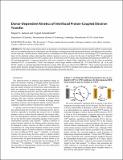| dc.contributor.author | Jackson, Megan | |
| dc.contributor.author | Surendranath, Yogesh | |
| dc.date.accessioned | 2018-04-23T18:31:09Z | |
| dc.date.available | 2018-04-23T18:31:09Z | |
| dc.date.issued | 2016-02 | |
| dc.date.submitted | 2016-01 | |
| dc.identifier.issn | 0002-7863 | |
| dc.identifier.issn | 1520-5126 | |
| dc.identifier.uri | http://hdl.handle.net/1721.1/114889 | |
| dc.description.abstract | The effect of the proton donor on the kinetics of interfacial concerted proton–electron transfer (CPET) to polycrystalline Au was probed indirectly by studying the rate of hydrogen evolution from trialkylammonium donors with different steric profiles, but the same pK[subscript a]. Detailed kinetic studies point to a mechanism for HER catalysis that involves rate-limiting CPET from the proton donor to the electrode surface, allowing this catalytic reaction to serve as a proxy for the rate of interfacial CPET. In acetonitrile electrolyte, triethylammonium (TEAH+) displays up to 20-fold faster CPET kinetics than diisopropylethylammonium (DIPEAH[superscript +]) at all measured potentials. In aqueous electrolyte, this steric constraint is largely lifted, suggesting a key role for water in mediating interfacial CPET. In acetonitrile, TEAH[superscript +] also displays a much larger transfer coefficient (β = 0.7) than DIPEAH[superscript +] (β = 0.4), and TEAH[superscript +] displays a potential-dependent H/D kinetic isotope effect that is not observed for DIPEAH[superscript +]. These results demonstrate that proton donor structure strongly impacts the free energy landscape for CPET to extended solid surfaces and highlight the crucial role of the proton donor in the kinetics of electrocatalytic energy conversion reactions. KEYWORDS: Proton-coupled electron transfer, hydrogen evolution, steric effects, interface,
transfer coefficient, kinetic isotope effects | en_US |
| dc.description.sponsorship | United States. Air Force. Office of Scientific Research (Award FA9550-15-1-0135) | en_US |
| dc.description.sponsorship | American Society for Engineering Education. National Defense Science and Engineering Graduate Fellowship | en_US |
| dc.language.iso | en_US | |
| dc.publisher | American Chemical Society (ACS) | en_US |
| dc.relation.isversionof | http://dx.doi.org/10.1021/jacs.6b00167 | en_US |
| dc.rights | Article is made available in accordance with the publisher's policy and may be subject to US copyright law. Please refer to the publisher's site for terms of use. | en_US |
| dc.source | Prof. Surendranath via Erja Kajosalo | en_US |
| dc.title | Donor-Dependent Kinetics of Interfacial Proton-Coupled Electron Transfer | en_US |
| dc.type | Article | en_US |
| dc.identifier.citation | Jackson, Megan N., and Yogesh Surendranath. “Donor-Dependent Kinetics of Interfacial Proton-Coupled Electron Transfer.” Journal of the American Chemical Society, vol. 138, no. 9, Mar. 2016, pp. 3228–34. | en_US |
| dc.contributor.department | Massachusetts Institute of Technology. Department of Chemistry | en_US |
| dc.contributor.approver | Surendranath, Yogesh | en_US |
| dc.contributor.mitauthor | Jackson, Megan | |
| dc.contributor.mitauthor | Surendranath, Yogesh | |
| dc.relation.journal | Journal of the American Chemical Society | en_US |
| dc.eprint.version | Author's final manuscript | en_US |
| dc.type.uri | http://purl.org/eprint/type/JournalArticle | en_US |
| eprint.status | http://purl.org/eprint/status/PeerReviewed | en_US |
| dspace.orderedauthors | Jackson, Megan N.; Surendranath, Yogesh | en_US |
| dspace.embargo.terms | N | en_US |
| dc.identifier.orcid | https://orcid.org/0000-0002-7978-5212 | |
| dc.identifier.orcid | https://orcid.org/0000-0003-1016-3420 | |
| mit.license | PUBLISHER_POLICY | en_US |
